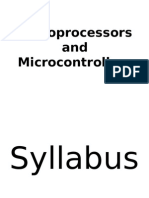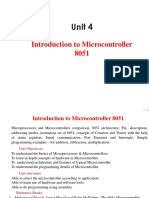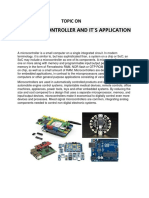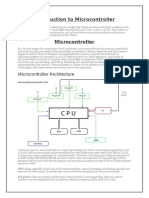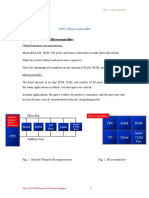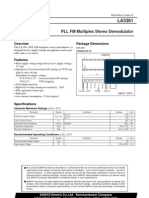MIT-WPU
School of Electronics and Communication Engineering
S.Y. B. Tech (SEM- IV)
Microcontroller and Applications
ECE2003B
Course Content
1. Introduction to Microcontroller
2. CIP-51 Architecture
3. Peripheral Interfacing and Programming-I
4. Peripheral Interfacing and Programming-II
Course Objectives & Course Outcomes:
Pre-requisites: Exposure to Digital Electronics
Course Objectives:
1. Knowledge:
Basics of Microprocessor and Microcontroller architecture and features
Integrated Development Environment (IDE) for developing microprocessor and
microcontroller-based applications.
Interfacing of a microcontroller with various peripherals.
2. Skills:
To write assembly language and embedded C programs.
To apply knowledge for the development of multidisciplinary projects.
3.Attitude:
To select the appropriate microcontroller for the desired application.
To develop real-world applications using a microcontroller.
Course Objectives & Course Outcomes:
Course Outcomes: After completion of this course students will be able to
1. Explain the architecture of the microcontroller (CL-II)
2. Make use of Integrated Development Environment (IDE) for programming and
debugging. (CL-III)
3. Apply knowledge of microcontroller interfacing with various peripherals for
developing real-world applications. (CL-III)
4. Compare various microcontrollers and select the appropriate microcontroller for the
desired application. (CL-IV)
Syllabus:
Unit 1
• Introduction to Microcontroller: Microprocessor and Microcontroller comparison, Microcontroller architecture
comparison, Role of microcontroller in Embedded System, Introduction to CIP-51 architecture and block diagram,,
Instruction set, and Assembly language programming.
Unit 2
• CIP-51 Architecture: Reset sources, Oscillator options, Memory Organization, Port structure, Timers, Timer programming,
Interrupt handler, Power management modes. (All programs in Embedded C).
Unit 3
• Peripheral Interfacing and Programming-I: Interfacing of LED, Relay, Buzzer, Switch, 7-segment display, LCD, Keypad,
Stepper Motor, DAC ADC programming, Programmable Counter Array (PCA), DC motor control using PWM (All programs
in Embedded C).
Unit 4
• Peripheral Interfacing and Programming-II: Basics of Serial Communication protocol:UART, study of RS 232,RS 485,
I2C, and SPI (All programs in Embedded C), Comparative study of various emerging microcontrollers, Microcontroller
application Case Study.
Laboratory Exercises / Practical:
List of Experiments:
1. Simple assembly language programming.
2. Complex assembly language programming.
3. Interfacing LED, Relay, Buzzer, and switch with C8051F340.
4. Interfacing LCD with C8051F340.
5. Interfacing DAC with C8051F340.
6. Interfacing ADC with C8051F340.
7. Interfacing DC motor and control its speed using PWM with C8051F340.
8. Interfacing UART with C8051F340.
9. Interfacing Stepper Motor with C8051F340.
10.Interfacing EEPROM using SPI with C8051F340.
11.Design and implement a microcontroller-based project.
UNIT-I
Introduction to Microcontroller
• Microprocessor and Microcontroller comparison,
• Microprocessors and microcontroller architecture comparison
• Role of microcontroller in Embedded System
• Introduction to CIP-51 architecture and block diagram
• Memory organization
• Instruction set
• Assembly programming
Terminologies:
• Integrated Circuit (IC): A miniaturized electronic circuit that consists of
semiconductor devices and passive components contained in a package
• Central Processing Unit (CPU): This refers to the core of the MCU that
executes code
• Microcontroller Unit (MCU): This is the standard acronym used for
microcontrollers, and refers to the full IC that contains the CPU and
peripherals.
• “n-bit” – the “n” refers to the data bus width of the CPU, and is the maximum
width of data it can handle at a time
• Examples: 8-bit MCU, 32-bit MCU
Micro-processors and Microcontrollers
• Microprocessor: General-purpose CPU/ General-purpose Processor
(GPP)
• Emphasis is on flexibility and performance
• Generic user-interface such as keyboard, mouse, etc.
• Used in a PC, PDA, cell phone, etc.
• Microcontroller: Microprocessor + Memory on a single chip
• Emphasis is on size and cost reduction
• The user interface is tailored to the application, such as the buttons on a TV
remote control
• Used in a digital watch, TV remote control, car and many common day-to-day
appliances
Microprocessor Vs Microcontroller
Microprocessor Microcontroller
1 It is only a processor, so memory and I/O Micro Controller has a processor along with internal
components need to be connected externally and memory and I/O components and having lower power
having higher power consumption consumption
2. Memory and I/O has to be connected externally, Memory and I/O are already present, and the internal
so the circuit becomes large. circuit is small.
3. Microprocessors are based on Von Neumann Micro controllers are based on Harvard architecture
model
4 High Processing Power in terms of instruction Low processing Power in terms of instruction
execution(MIPS) execution(MIPS)
5 CPU word size can be 16/ 32/64 bit CPU word size can be 8/16/32 bit
6 It has no RAM, ROM, Input-Output units, timers, It has a CPU along with RAM, ROM, and other
and other peripherals on the chip. peripherals embedded on a single chip.
7 It’s used for general purpose It’s used for application-specific systems.
applications that allow you to handle loads of
data
https://raspberrytips.com/is-raspberry-pi-a-microcontroller/
Microprocessor Vs Microcontroller
Microprocessor Microcontroller
General purpose Processor Application specific
Bulkier and Expensive A single chip and cost effective
High computing power Can perform limited calculations
More power consumption Less power consumption
Only word/ byte transferable Also bit transferable
Pins are fixed Port pins are programmable
Eg. Intel 8085, 8086, Motorola’s Eg. Intel’s MCS-51, Atmel’s AT89c51
680x
Role of microcontroller in Embedded System
• A combination of hardware and software designed to perform a dedicated
function
• Embedded systems are computing systems with tightly coupled hardware
and software integration.
• Designed to perform dedicated function
• Embedded systems are part of a larger system or product,
-e.g., antilock braking system in a car
• Embedded systems are tightly coupled to their environment → imposes real-
time constraints by the need to interact with the environment
Embedded Products Using Microcontrollers (Applications)
• Home
• Appliances, intercom, telephones, security systems, garage door openers, answering
machines, fax machines, home computers, TVs, cable TV tuner, VCR, camcorder,
remote controls, video games, cellular phones, musical instruments, sewing machines,
lighting control, paging, camera, pinball machines, toys, exercise equipment
• Office
• Telephones, computers, security systems, fax machines, microwave, copier, laser
printer, color printer, paging
• Auto
• Trip computer, engine control, air bag, instrumentation, security system, transmission
control, entertainment, climate control, cellular phone, keyless entry
Is 8-bit Still Relevant?
• “n-bit” – the “n” refers to the data bus width of the CPU, and is the
maximum width of data it can handle at a time
• 8-bit microcontrollers are sufficient and cost-effective for many
embedded applications
• More and more advanced features and peripherals are added to 8-bit
processors by various vendors
• 8-bit MCUs are well-suited for low-power applications that use
batteries
The 8051 Microcontroller—A Brief History
• In 1980, Intel introduced the 8051
• First device in the MCS-51® family of 8-bit microcontrollers
• In addition to Intel there are other second source suppliers of the ICs, who
make microcontrollers that are compatible with the 8051 architecture.
• In recent years some companies have incorporated many different and
additional features into 8051
• In 2000, Silicon Laboratories introduced CIP-51 microcontroller chip
(C8051F340) based on the 8051 core CPU
https://www.manualslib.com/manual/152880/Silicon-Laboratories-
C8051f341.html?page=73#manual
Important Basics Microcontroller
(Small sized Computer)
Differences between Von Neumann and Harvard
architecture
Comparison of Von Neumann and Harvard
Von Neumann architecture Harvard architecture
– Fetches instructions and – Fetches Instruction and Data
data from a single from two separate memory
memory space spaces
– Limits operating bandwidth – Improved operating bandwidth
– Allows for fixed bus widths – Allows for different bus widths
– Architecture --- CISC – Architecture --- RISC
– Variable instruction format – Fixed instruction format
Control Unit
Hardwired v/s Micro-programmed Control Unit To execute an
instruction, there are two types of control units Hardwired
Control unit and Micro-programmed control unit.
1.Hardwired control units are generally faster than
microprogrammed designs. In hardwired control, all the
control signals required inside the CPU can be generated using
a state counter and a PLA circuit.
2.A microprogrammed control unit is a relatively simple logic
circuit that is capable of sequencing through microinstructions
and generating control signals to execute each
microinstruction.
Concept of Pipeline
Fetch
Decode
Execute
RISC vs. CISC Architecture
CISC
RISC
1. Complex Instruction taking multiple
1.Simple Instruction taking 1 cycle
cycles
2.Only LOADs, STOREs access
2. Any Instruction may access memory
memory
3. Designed around Instruction Set
3.Designed around pipeline
4. Instruction interpreted by micro
4.Instruction executed by h/w
program
5.Fixed format Instruction
5. Variable format Instruction
6.Few Instruction and modes
6. Many Instruction and modes
7.Complexity in the compiler
7. Complexity in the micro program
8.Multiple register sets
8. Single register set
Introduction to CIP-51 Core (1st Unit is focused on CIP -51
Core
Block Diagram C8051F340
Memory Organization of C8051F340 (Will be referred again in unit 2)
1. 64 KB ROM for writing code
2. 256 bytes data memory
space
3. Additional storage of 4kB
4. Program counter (PC) is
register which contains
current location(Address) of
code execution in code
memory.
5. Data pointer register(DPTR)
can point to data memory.
Memory Organization of C8051F340 (Will be referred again in unit 2)
Memory Classes and Layout
Memory Classes and Layout introduces the different memory types used to programming the 8051 microcontroller and
variants. Memory classes identify distinct physical memory regions, which can be represented in a memory layout. Physical
memory regions in an A51 system include:
Program Memory: in the classic 8051, this is a 64KB space called CODE. Typically, this region is a ROM space that used for
the program code and constants. Constants are fetched with the MOVC instruction.
Internal Data Memory: in the classic 8051, this is the on-chip RAM space with a maximum of 256 Bytes containing register
banks, BIT space, direct addressable DATA space, and indirect addressable IDATA space. This region should be used for
frequently used variables.
External Data Memory: in classic 8051 devices, this area, called XDATA, is off-chip RAM with a space of up to 64KB.
However, several new 8051 devices have additional on-chip RAM that is mapped into the XDATA space. Usually, this
additional on-chip RAM has to be enabled via dedicated SFRs.
1. First 32 bytes of memory
location in RAM are used as
registers.(R0 to R7)
2. Register banks are selected
by RS1 and RS0 bits in the
program status word
Instruction Set and Assembly Programming
• An instruction is made up of an operation code (op-code) followed by either zero,
one or two bytes of operands
• The op-code identifies the type of operation to be performed while the operands
identify the source and destination of the data
• The operand can be:
• The data value itself
• A CPU register
• A memory location
• An I/O port
• An assembly language instruction has four fields:
• [Label:] mnemonic [operands] [;comments]
• Eg. MOV A, #00H ;put 0 in the accumulator
• A = 00000000
https://www.manualslib.com/manual/152880/Silicon-Laboratories-
C8051f341.html?page=78#manual
Instructions Format
Assembly language instructions specify the program code that is to be assembled by the Ax51 assembler.
The Ax51 assembler translates the assembly instructions in your program into machine code and stores the resulting code
in an object file.
Assembly instructions have the following general format:
<[>label:<]> mnemonic <[>operand<]> <[>, operand<]> <[>/, operand<]> <[>; comment<]>
label symbol name that is assigned the address at which the instruction is located.
mnemonic is the ASCII text string that symbolically represents a machine language instruction.
operand is an argument that is required by the specified mnemonic.
is an optional description or explanation of the instruction. A comment may contain any text
comment
you wish. Comments are ignored by the assembler.
Using Operands and Expressions
Assembler instructions support a wider variety of operands than do directives. Some instructions require no
operands and some may require up to 3 operands. Multiple operands are separated by commas. For example:
MOV R2, #0
The number of operands that are required and their types depend on the instruction or directive that is
specified. In the following table, the first four operands can also be expressions. Instruction operands can be
classified as one the following types:
Addressing Modes
• Five modes of addressing
• The different addressing modes determine how the
operand byte is selected
Addressing Modes Instruction
Description
Register MOV A, B
Operand is in register
Operand is in memory location(register to
Direct MOV 30H,A
memory location transfer
Indirect ADD A,@R0 Operand address is in the register
Operand is specified in the instruction itself
Immediate ADD A,#80H
Operand is at address specified by
Indexed MOVC A,@A+PC
register+address pointer
Important Registers for
programming in
Assembly
Different Versions of MOV Instruction
Different Versions of MOV Instruction
Different Versions of ADD Instruction
Mnemonics
Assembler Directives and Data Type
• Assembler Directives
• ORG
• EQU
• END
• Data Type:
• DB
Note: For the mnemonic, number of bytes, and number of clock cycles for
each instruction refer Table 9.1 in the datasheet
Many instructions have required arguments that are described in the following table:
Argument Description
Addr11 An 11-bit address destination. This argument is used by ACALL and AJMP instructions. The target of the
(11 bit address) CALL or JMP must lie within the same 2K page as the first byte of the following instruction.
Addr16
A 16-bit address destination. This argument is used by LCALL and LJMP instructions.
(16 bit address)
bit A direct addressed bit in internal data RAM or SFR memory.
direct An internal data RAM location (0-127) or SFR (128-255).
immediate A constant included in the instruction encoding.
A signed (two's complement) 8-bit offset (-128 to 127) relative to the first byte of the following
offset
instruction.
@Ri An internal data RAM location (0-255) addressed indirectly through R0 or R1.
Rn Register R0-R7.
Arithmetic Flags
Flag: It is a 1-bit register that indicates the status of
the result from an operation
Flags are either at a flag-state of value 0 or 1
Arithmetic flags indicate the status of the results from
mathematical operations ( +, −, *, / )
There are 4 arithmetic flags in the 8051
Carry (C)
Auxiliary Carry (AC)
Overflow (OV)
Parity (P)
Program Status Word (PSW)or Flag Register
Bit 7 Bit 6 Bit 5 Bit 4 Bit 3 Bit 2 Bit 1 Bit 0
CY AC FO RS1 RS0 OV UD P
Symbol Function
CY Carry flag
AC Auxiliary Carry flag (For BCD Operations)
F0 Flag 0 (Available to the user for General Purpose)
RS1, Register bank select:
RS0 RS1 RS0 Working Register Bank and Address
0 0 Bank0
0 1 Bank1
1 0 Bank2 (D:0x10 - D:0x17)
1 1 Bank3 (D:0x18H - D:0x1F)
0V Overflow flag
UD User definable flag
P Parity flag; P=1 for Odd no. of 1’s; P=0 for Even no.
of 1’s
Related Terms
Micro Controller performs all operations in hex
https://developer.arm.com/documentation/101655/0961/8051-Instruction-Set-Manual/Instructions/MOV?lang=en
MOV instruction Documentation
C8051F340 Instruction set
MOV dest, source dest source
Sr. No Mnemonic Description
Data Transfer Instruction
1 MOV A, Rn Move register to accumulator
2 MOV A, direct Move direct byte to accumulator
3 MOV A, @ Ri Move indirect RAM to accumulator
4 MOV A, #data Move immediate data to accumulator
5 MOV Rn, A Move accumulator to register
6 MOV Rn, direct Move direct byte to register
7 MOV Rn, #data Move immediate data to register
8 MOV direct, A Move accumulator to direct byte
9 MOV direct, Rn Move register to direct byte
10 MOV direct, direct Move direct byte to direct
11 MOV direct, @Ri Move indirect RAM to direct byte
12 MOV direct, #data Move immediate data to direct byte
13 MOV @Ri, A Move accumulator to indirect RAM
14 MOV @Ri, direct Move direct byte to indirect RAM
15 MOV @Ri, #data Move immediate data to indirect RAM
Data Transfer Instructions
16 MOV DPTR, #data 16 Load data pointer with a 16-bit constant
17 MOVC A, @A+DPTR Move code byte relative to DPTR to accumulator
18 MOVC A,@A+PC Move code byte relative to PC to accumulator
19 MOVX A, @Ri Move external RAM (8-bit addr) to accumulator
20 MOVX A, @DPTR Move external RAM (16-bit addr) to accumulator
21 MOVX @Ri, A Move accumulator to external RAM (8-bit addr)
22 MOVX @DPTR,A Move accumulator to external RAM (16-bit addr)
23 PUSH direct Push direct byte onto stack
24 POP direct Pop direct byte from stack
25 XCH A, Rn Exchange register byte with accumulator
26 XCH a, direct Exchange direct byte with accumulator
27 XCH A, @Ri Exchange indirect RAM with accumulator
28 XCHD A, @Ri Exchange low order digit indirect RAM with
accumulator
Arithmetic Instructions
Sr. No Mnemonic Description
29 ADD A, Rn Add register to accumulator
30 ADD A, Direct Add direct byte to accumulator
31 ADD A, @ Ri Add indirect RAM to accumulator
32 ADD A, #data Add immediate data to accumulator
33 ADDC A, Rn Add register to accumulator with carry
34 ADDC A, direct Add direct byte to accumulator with carry
35 ADDC A, @Ri Add indirect RAM to accumulator with carry
36 ADDC A, #data Add immediate data to accumulator with carry
37 SUBB A, Rn Subtract register from accumulator with borrow
38 SUBB A, Direct Subtract direct byte from accumulator with borrow
39 SUBB A, @Ri Subtract indirect RAM from accumulator with
borrow
40 SUBB A, #data Subtract immediate data from accumulator with
borrow
Arithmetic Instructions
41 INC A Increment Accumulator
42 INC Rn Increment register
43 INC direct Increment direct byte
44 INC @Ri Increment indirect RAM
45 DEC A Decrement accumulator
46 DEC Rn Decrement register
47 DEC direct Decrement direct RAM
48 DEC @Ri Decrement indirect RAM
49 INC DPTR Increment data pointer
50 MUL AB Multiply A and B
51 DIV AB Divide A by B
52 DA A Decimal adjust accumulator
Logical Instructions
Sr. Mnemonic Description
No
53 ANL A, Rn AND register to accumulator
54 ANL A, Direct AND direct byte to accumulator
55 ANL A, @ Ri AND indirect RAM to accumulator
56 ANL A, #data AND immediate data to accumulator
57 ANL direct, A AND accumulator to direct byte
58 ANL direct, #data AND immediate data to direct byte
59 ORL A, Rn OR register to accumulator
60 ORL A, direct OR direct byte to accumulator
61 ORL A, @Ri OR indirect RAM to accumulator
62 ORL A, #Data OR immediate data to accumulator
63 ORL direct, A OR accumulator to direct byte
Logical Instructions
64 ORL direct, #data OR immediate data to direct byte
65 XRL A, Rn EX-OR register to accumulator
66 XRL A, direct EX-OR direct byte to accumulator
67 XRL A, @Ri EX-OR indirect RAM to accumulator
68 XRL A, #Data EX-OR immediate data to accumulator
69 XRL direct, A EX-OR accumulator to direct byte
70 XRL direct, #data EX-OR immediate data to direct byte
71 CLR A Clear Accumulator
72 CPL A Complement Accumulator
73 RL A Rotate accumulator left
74 RLC A Rotate accumulator left through carry
75 RR A Rotate accumulator right
76 RRC A Rotate accumulator right through carry
77 SWAP A Swap nibbles within the accumulator
Boolean Variable Manipulation Instructions
Sr. No Mnemonic Description
78 CLR C Clear Carry
79 CLR bit Clear direct bit
80 SETB C Set Carry
81 SETB bit Set direct bit
82 CPL C Complement carry
83 CPL bit Complement direct bit
84 ANL C, bit AND direct bit to carry
85 ANL C, /bit AND complement of direct bit to carry
86 ORL C, bit OR direct bit to carry
87 ORL C, /bit OR complement of direct bit to carry
88 MOV C, bit Move direct bit to carry
89 MOV bit, C Move carry to direct bit
90 JC rel Jump if carry is set
91 JNC rel Jump if carry not set
92 JB bit, rel Jump if direct bit is set
93 JNB bit, rel Jump is direct bit is not set
94 JBC bit, rel Jump if direct bit is set and clear bit
Instructions that affect PSW
X can be 0 or 1
Program Branching Instructions
Sr. No Mnemonic Description
95 ACALL addr11 Absolute subroutine call
96 LCALL addr16 Long subroutine call
97 RET Return from subroutine
98 RETI Return from interrupt
99 AJMP addr11 Absolute Jump
100 LJMP addr16 Long Jump
101 SJMP rel Short Jump (relative addr)
102 JMP @A+DPTR Jump indirect relative to DPTR
103 JZ rel Jump is accumulator is zero
104 JNZ rel Jump if accumulator is not zero
105 CJNE A, direct, rel Compare direct byte to accumulator and jump if not equal
106 CJNE A, #data, rel Compare immediate to accumulator and jump if not equal
107 CJNE Rn, #data, rel Compare immediate to register and jump if not equal
108 CJNE @Ri, #data, rel Compare immediate to indirect and jump if not equal
109 DJNZ Rn, rel Decrement register and jump if not zero
110 DJNZ direct, rel Decrement direct byte and jump if not zero
111 NOP No operation
The flag bits affected by the ADD instruction are CY, P, AC, and OV
Assembly Programs
▪ Addition of n 8-bit numbers
▪ Addition of BCD numbers
▪ Addition of two 16-bit numbers
▪ Find square of a number using DPTR
▪ Program to count number of Odd and Even numbers from a given
array
▪ Program to count number if Positive and Negative numbers from a
given array
MOV/MOVC/MOVX Instructions
MOV
• The MOV instruction moves data bytes between the two specified operands. The byte
specified by the second operand is copied to the location specified by the first operand. The
source data byte is not affected.
• MOV A, #0FFh
• MOV A, R6
MOVC
The MOVC instruction moves a byte from the code or program memory to the accumulator
• MOV A, @A+PC
MOVX
The MOVX instruction transfers data between the accumulator and external data memory.
External memory may be addressed via 16-bits in the DPTR register or via 8-bits in the R0 or R1
registers. When using 8-bit addressing, Port 2 must contain the high-order byte of the address.
• MOVX A, @R1
• MOVX A, @DPTR
Program 1:Addition of two 16bit Numbers
Algorithm
• Consider first 16 bit operand:AB20H
• Consider second 16 bit operand :65DE
• Result must be stored such that : MSB Byte in R0
: LSB Byte in R1
Carry Reflected in carry flag
Result of Addition is 110FE
Carry
Some instructions related to carry Flag
ADDC
The ADDC instruction adds a byte value and the value of the carry flag to the
accumulator. The results of the addition are stored back in the accumulator.
Several of the flag registers are affected.
Example: ADDC A, #23h
CLR
The CLR instruction sets the specified destination operand to a value of 0.
Example: CLR C
SETB
• The SETB instruction sets the bit operand to a value of 1. This instruction can
operate on the carry flag or any other directly addressable bit. No flags are
affected by this instruction.
Example: SETB C
Program1: Addition of two 16 bit Numbers
ORG 0000H ; Operand 1 (AB20H) Operand 2 (65DE)
CLR C ;MAKE CY=0
MOV A,#020H ;LOWER BYTE OF OPERAND 1(20H) IN A
ADD A,#0DEH ;ADD LOWER BYTE OF OPERAND (DE)2 WITH A
MOV R1,A ;STORE Lower byte OF RESULT IN R1
MOV A,#65H ;HIGHER BYTE OF OPERAND 2 IN A
ADDC A,#0ABH ; ADD WITH HIGHER BYTE OF OPERAND 1
MOV R0,A ;STORES MSB OF RESULT IN R0
END
Increment /Decrement
INC
The INC instruction increments the specified operand by 1. An original
value of 0FFh or 0FFFFh overflows to 00h or 0000h. No flags are
affected by this instruction.
Example: INC A(A=A+1) register content increment
INC 34h Address increment
INC DPTR
INC Rn
Logical: OR, XOR, AND, SWAP
MOV A, #20H //0010 0000//
MOV R0, #03H //0000 0011//
XRL A, R0 // 0010 0011//
What will be the content in A ?
MOV A, #20H //0010 0000//
MOV R0, #03H //0000 0011//
SWAP A // A= 02H //
Addition of 5, 8 bit numbers
• Use memory location 0x40 to 0x44 for storing numbers
• Address location 45 and 46 is used for storing result
• Address pointer is set in R0
• N bit value is set in R2(5 in our case)(Count Register)
• Set result location and accumulator to 0
• Add first number at location 0X40 with accumulator
• If carry is generated increment value at address 0x45H
• If no carry increment address pointer in R0, and decrement count register
• Go on decrementing R2 till it becomes zero.
• Store the result in accumulator at memory location 0x46H
Jump Instructions(Unconditional)
JMP
The JMP instruction transfers execution to the address generated by adding
the 8-bit value in the accumulator to the 16-bit value in the DPTR register.
Neither the accumulator nor the DPTR register are altered. No flags are
affected by this instruction.
JMP @A+DPTR
AJMP LABEL
The destination address must be located in the same 2KByte block of
program memory as the opcode following the AJMP instruction. No
flags are affected.
LJMP
• The LJMP instruction transfers program execution to the specified 16-bit
address.
Jump Instructions(Unconditional)…
SJMP
• The SJMP instruction transfers execution to the specified address. The
address is calculated by adding the signed relative offset in the
second byte of the instruction to the address of the following
instruction. The range of destination addresses is from 128 before the
next instruction to 127 bytes after the next instruction.
SJMP Label
Conditional branching or jump instructions
JC
The JC instruction branches to the specified address if the carry flag is set.
Otherwise, execution continues with the next instruction. No flags are
affected by this instruction.
JC LABEL
JB
• The JB instruction branches to the address specified in the second operand
if the value of the bit specified in the first operand is 1. The bit that is
tested is not modified. No flags are affected by this instruction.
• JB bit, offset
• JB P1.2 LABEL
Conditional branching or jump instructions
CJNE
The CJNE instruction compares the first two operands and branches to
the specified destination if their values are not equal. If the values are
the same, execution continues with the next instruction.
• CJNE A, #01H, LABEL
DJNZ
The DJNZ instruction decrements the byte indicated by the first
operand and, if the resulting value is not zero, branches to the address
specified in the second operand.
Addition of 5(N), 8 bit numbers stored in
memory Memory Location Data Values
40H 01H
ORG 0000H
MOV R0, #40H 41H 02H
MOV R2, #05H
MOV 46H,#00H 42H 03H
MOV 45H,#00H
MOV A,#00H 43H 04H
LABEL2:ADD A,@R0
JNC LABEL1 44H 05H
INC 45H
LABEL1:INC R0 45H 00H(MSB of result)
DJNZ R2, LABEL2
46H 00H(LSB of result)
MOV 46H,A
END
Special Insructions
DA
The DA instruction adjusts the eight-bit value in the Accumulator resulting from the earlier addition of two
variables (each in packed-BCD format), producing two four-bit digits. Any ADD or ADDC instruction may have
been used to perform the addition.
If Accumulator bits 3-0 are greater than nine (xxx1010-xxx1111), or if the AC flag is one, six is added to the
Accumulator, producing the proper BCD digit in the low-order nibble. This internal addition would set the
carry flag if a carry-out of the low-order four-bit field propagated through all high-order bits, but it would
not clear the carry flag otherwise.
If the carry flag is now set, or if the four high-order bits now exceed nine (1010xxx-111xxxx), these high-
order bits are incremented by six, producing the proper BCD digit in the high-order nibble. Again, this would
set the carry flag if there was a carry-out of the high-order bits, but would not clear the carry. The carry flag
thus indicates if the sum of the original two BCD variables is greater than 100, allowing multiple precision
decimal addition. OV is not affected.
All of this occurs during the one instruction cycle. Essentially, this instruction performs the decimal
conversion by adding 00H, 06H, 60H, or 66H to the Accumulator, depending on initial Accumulator and PSW
conditions.
Find square of a number using DPTR
ORG 0000H
MOV DPTR, #300H ; load look-up table address
BACK: MOV A, #09 ; get X
MOVC A, @A+DPTR ; get X square from table
MOV 40H , A
SJMP BACK ; keep doing it
ORG 300H
TABLE: DB 0, 1, 4, 9, 16, 25, 36, 49, 64, 81
END
Finding Square of Number
1.Initialize R0 with memory address where all squares are stored and R1 with 0.
2.Increment R1 to find the square of a number.
3.Find the square of a number by multiplying A and B with same number.
4.Store the result with the assigned address array.
ORG 0000h
LJMP MAIN
ORG 40h
MAIN: MOV R0,#10H ; memory address where all the squares will be stored
MOV R1,#00
LOOP: INC R1 ;incrementing each time to generate a new square
MOV A,R1
MOV B,R1
MUL AB ;finding the square of a number
MOV @R0,A ;storing the square of all the numbers in an array
INC R0
CJNE R1,#10,LOOP ; checking the counter value whether it has reached zero
END
Rotate Instructions
RL
The RL instruction rotates the eight bits in the accumulator left one bit
position. Bit 7 of the accumulator is rotated into bit 0, bit 0 into bit 1,
bit 1 into bit 2, and so on. No flags are affected by this instruction.
Example RL A
RR
The RR instruction rotates the eight bits in the accumulator right one
bit position. Bit 0 of the accumulator is rotated into bit 7, bit 7 into bit
6, and so on. No flags are affected by this instruction.
Example RR A
MOV A, #25h
Rotate RR A
Instructions
What will be the content in A ?
MIT-WPU ECE
Program to count number of 1’s in a given
byte describes RRC Instruction
MOV R1, #00H ; Register to store count
MOV R2, #08H ; Loop variable
MOV A, #0FF ; Take any number here its 0x FF
back: RRC A ; Rotate right through carry flag
JC count ; If carry is 1 increment counter
SJMP next ; go to next counting
count: INC R1 ; counting number of ones in memory
Next: DJNZ R2, back; Continue to count till all bits are
checked
END
Program to count number of Odd and Even numbers from
a given array(Describes DIV AB)
ORG 0000H
MOV R2, #00H Uses DIV AB instruction: Divides accumulator with B register
MOV R3, #00H The resulting quotient is placed in the accumulator. Remainder
MOV R0, #40H
MOV R4,#05
Is placed in B register. If remainder is 1 then number is odd.
back: MOV A, @ R0; take the first number in acc
MOV B , #02H; immediate value 2 in reg B
DIV AB; divide A by B
INC R0
MOV R1, B, Shift remainder in R1
CJNE R1, #00H, odd, if R1 is not zero number is odd
SJMP even; otherwise number is even
Odd: INC R2 ;R2 for odd
DJNZ R4, back
Even: INC R3 ;R3 for Even
DJNZ R4, back ;check this for all 5 nos stored in memory
END
Program to find positive and negative
numbers(Describes RLC and use of carry flag)
• A negative number has its MSB as binary 1. Hence rotate the number
through carry to the left and then decide upon status of carry flag
ORG 0000H ; Origin
MOV A,#08h ; move immediate number
RLC A ; Rotate accumulator left through carry
JC Negative ; If carry present number is negative move to label negative
Negative: MOV A, #01H ; moving 0 to acc show number is positive
Positive: MOV A, #00h ; Moving 0 to acc to show number is Positive
END
Addition of 8 bit 2 digit BCD(Describes use of
call and RET use of equate directive, DA A)
; R5=R1+R2
ORG 000H
BCD_1 EQU 20H
BCD_2 EQU 90H
MAIN: MOV R1, #BCD_1
MOV R2, #BCD_2
LCALL BCDADD
SJMP MAIN
BCDADD:MOV A,R1
ADD A,R2
DA A
MOV R5, A
RET
END
References
https://www.silabs.com/documents/public/datasheets/C8051F34x.pdf
Muhammas Mazidi, Janice Mazidi and Rolin McKinlay,
“ The 8051 Microcontroller and Embedded Systems using Assembly and C”,
Pearson Education, 2nd edition
Instruction set
http://www.keil.com/support/man/docs/is51/is51_xch.htm




